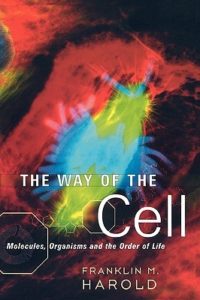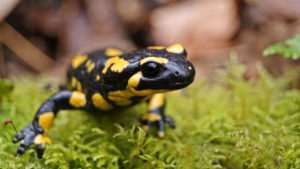Professor Franklin Harold of Colorado State University, described as "one of the world's most respected microbiologists" has included some fascinating observations in his book The Way of the Cell on the subject of abiogenesis. The mini-reviews on his book's back cover lend some credibility to the claim about Dr. Harold's professional credentials, one being written by renowned biologist Lynn Margulis, who said, "Witty and erudite, this scientific book hails as a literary achievement.Comprehensive and up to date, Franklin Harold traces the roots--historical, thermodynamic, and biochemical--of today's biological revolution." His chapter titled "Searching for the beginning" is so remarkable, it seems prudent to start at the beginning. Dr. Franklin writes, "Of all the unsolved mysteries remaining in science, the most consequential may be the origin of life. This opinion is bound to strike many readers as overblown, to put it mildly. Should we not rank the Big Bang, life in the cosmos, and the nature of consciousness on at least an equal plane? My reason for placing the origin of life at the top of the agenda is that resolution of this question is required in order to anchor living organisms securely in the real world of matter and energy, and thus relieve the lingering anxiety as to whether we have read nature's book correctly. Creation myths lie at the heart of all human cultures, and science is no exception; until we know where we come from, we do not know who we are. The origin of life is a stubborn problem, with no solution in sight. There is indeed a large and … [Read more...]
The Watchmaker Analogy: a slight return
I am something of an advocate for William Paley's famous (but admittedly flawed and allegedly "debunked") Watchmaker analogy, as this previous article titled "A Blind Rock Maker?" should establish. As my previous article stipulates, the problem with the analogy is not natural selection, or that the idea of design is nothing more than a beguiling illusion, but in the mistaken notion that the rock itself might have always existed. We now know (or think we know) our universe had a beginning, and the rock simply couldn't have existed forever. Even the rock had an origin. By Tony Freeth - Original publication: The Antikythera Mechanism Research ProjectImmediate The Antikythera Mechanism Research Project, Fair use, https://en.wikipedia.org/w/index.php?curid=36445604 Today we have a new hypothetical scenario: what if we stumble across a stone in the forest (or, in the case, at the bottom of the ocean) that on closer inspection, appears to have sophisticated wheels and machinery for some strange, unknown purpose? The image above is a computer-generated replica of the back panel of the Antikythera device, discovered by sponge divers in a rock found among wreckage from a shipwreck located offshore from the Greek island Antikthera in 1900. The mechanism is truly extraordinary, and appears to have been designed to track (among other things) the Metonic cycle, a period of every nineteen years during which the reoccur at the same time of year, and the movement of the five known planets at the time. The inner workings are composed of at least 30 gears with a precise number of … [Read more...]
The problem with pterosaurs
According to The Science TM pterosaurs (allegedly) lived between 228 and 66 million years ago. Does the existence of pterosaur fossils prove that Science is true, and the Bible is false? After all, a literal interpretation of the Bible suggests the Earth is young, between 6,000 to 10,000 years old. This number is achieved by adding together the chronological age of every named generation beginning with Adam through Jesus, plus another 2,000 or so years. Of course, the Bible also says that 1,000 years is like a single day to God, so there might be some wiggle room. But 4 billion years versus 10,000? That’s a lot of wiggle room. However, the preferred method used to date rocks that are allegedly millions of years old is radiometric dating, which is notoriously unreliable means of dating. This fact was proved by dating rocks known to have been produced by the Mt. Saint Helen’s eruption in 1980 as being between 350,000 and 2.8 million years old. Oddly enough, the argument against using radiometric dating is that the age of the sample tested was known, which made the test invalid. Knowing the age of the rock is what made the test interesting. If the only way to get “accurate” readings from a rock is to not know the age of that rock, the results of the test are based on a guess. Then there is the problem of soft tissue being found in dinosaur bones. In 2005 paleontologist Mary Schweitzer made international headlines when she announced the discovery of collagen fibers in the fossilized bones of a young Tyrannosaurus Rex. Schweitzer nearly lost her job for … [Read more...]
Ring species
The PBS Evolution Library has an entry called Ring Species: Salamanders. The article discusses the breeding patterns of the Ensatina salamanders found on the Pacific coast and describes them as, "all descended from a common ancestral population. [of salamander]" The ring species of Ensatina salamanders is described as, "From one population to the next, in a circular pattern, these salamanders are still able to interbreed successfully. However, where the circle closes -- in the black zone on the map in Southern California -- the salamanders no longer interbreed successfully. The variation within a single species has produced differences as large as those between two separate species." To which I say, so what? There is a big difference between "don't" and "can't." One wonders if these different types of salamanders no longer interbreed by choice or if they became biologically incapable of mating. Why do they stop interbreeding? Do we know, or only think we know? Besides, whether they interbreed or not, these creatures all have the same salamander genome. We see the exact same behavior with dog breeding -- most people know that you can put together two (male and female) dogs of the same breed and you'll get purebred puppies, but if you put together two dogs of different breeds and allow them to mate, you'll get a mutt. Chihuahuas and Great Danes don't successfully mate very well due to physical limitations, and yet we still say we only have one species of canine. Yet with wild species, the slightest variation in kind can result in the declaration by … [Read more...]
Evolutionary Creation is for suckers
A friend of mine sent me this link at Biologos to an article titled "Evolutionary Creation is for Everyone", probably knowing full well the sort of reaction that provocative title would get from me, a reaction of the knee-jerk variety. While I hold no animus toward the Biologos organization, this sort of nonsense is what happens when Christians try to compromise with secular beliefs. Darwin's theory of shapeshifting is actually a very poor explanation for the complexity of life, and yes, I'm about to explain why. The reason I say that evolutionary creation is an attempt to compromise Christian beliefs with atheistic ones is because I've read the books by popular (atheist) biologists such as Richard Dawkins, Jerry Coyne, and P. Z. Myers, and these "experts" all preach that creationism is nonsense, and evolution is truth. It is an attempt to compromise with people uninterested in compromise. These secular scientists will acknowledge that people like Francis Collins and Ken Miller are good scientists, but imply they are mentally unstable for being Catholic and claiming evolution and creation is both true. Are evolution and creation both true, or are they mutually exclusive beliefs? It seems to depend on whom one asks. Advocates of evolution prefer to make arguments from authority, and have written books considered academic works, yet bearing ludicrous titles such as Evolution and the Myth of Creation. Author/Professor Tim Berra became famous for committing what has come to be known as "Berra's Blunder" because he used an obvious example of intelligent design in a … [Read more...]





